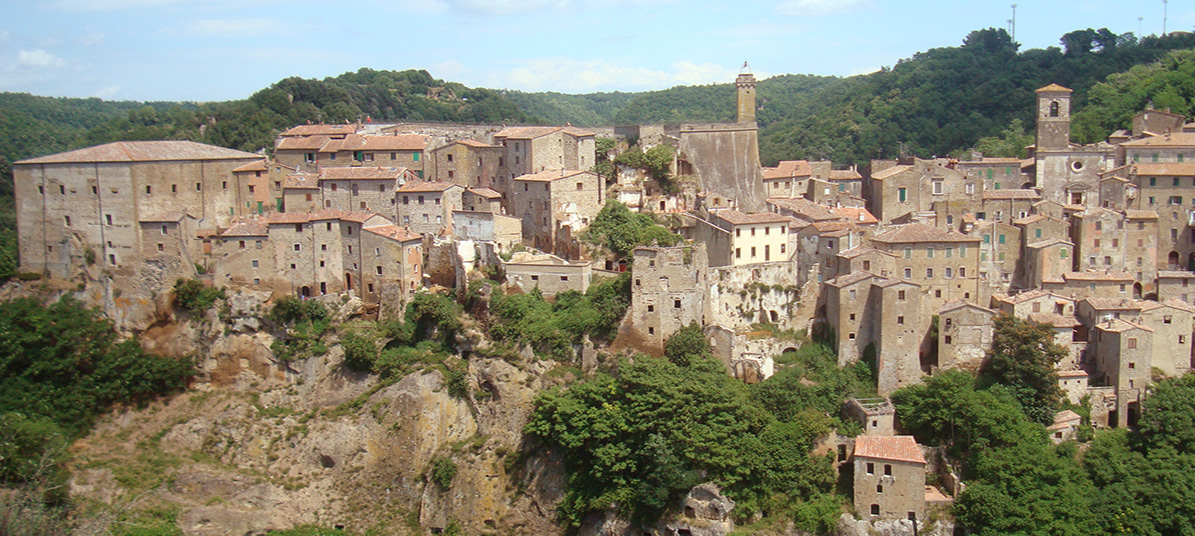| |

|
 |

|
 
 |
|
Southern Tuscany is an undiscovered jewel. Hidden away from mass-tourism, discover a piece of
Italy which remains largely unchanged both nature and lifestyle-wise.
The peacefulness of the countryside, the various unique villages and the
friendly atmosphere will no doubt pleasantly surprise you.
Bordering the Lazio region, the "Maremma" is one of the most beautiful areas in Tuscany. Endowed with significant natural and environmental resources, the Maremma is today one of the best tourist destinations in Italy, a region where ancient traditions have survived and Tuscan culture is preserved.
The Etruscan civilization was the first one to settle the productive earth of the Maremma area. Its subsequent inhabitants were the Romans, who developed a significant part of the soil into a fertile agricultural and cattle-raising one. The Romans started as well to develop the Maremma into a holiday area, building gorgeous villas and temples in the surroundings of the seacoast and near the numerous sulphurous thermal springs placed in the territory.
The Tuff Area is named after tufo, a volcanic, porous rock commonly used as a building material. The tuff has been carved over the centuries to build houses, cellars, tombs or used to make "tufi", big square bricks which are typical of the villages and towns of this area of the hills of the Maremma.
The major centres of this area, which has still not experienced mass tourism, are Pitigliano, Sorano and Manciano. The perfectly preserved necropolises in Sovana and Poggio al Buco, the vie cave (amazing roads carved in tuff that pass through the woods), and medieval villages like Magliano in Toscana contribute to make this area one of the most beautiful in Tuscany. It also boasts naturalistic treasures such as the hot springs and spas of Saturnia, and the hills of the river Fiora, which supplies water to the vast majority of the Maremman villages and towns.
Pitigliano is one of the most scenographic villages of Tuscany. Bounded on three sides by three rivers (Lente, Meleta and Procchio) the village rises on a tufaceous promontory of the north-western slopes of the Volsini mountains. Pitigliano is known as Piccola Gerusalemme, or Little Jerusalem after the large Jewish population settling here in the middle of the 16th century. You can take an interesting trip underground and see the remains of the older Jewish quarter.
|
|
|
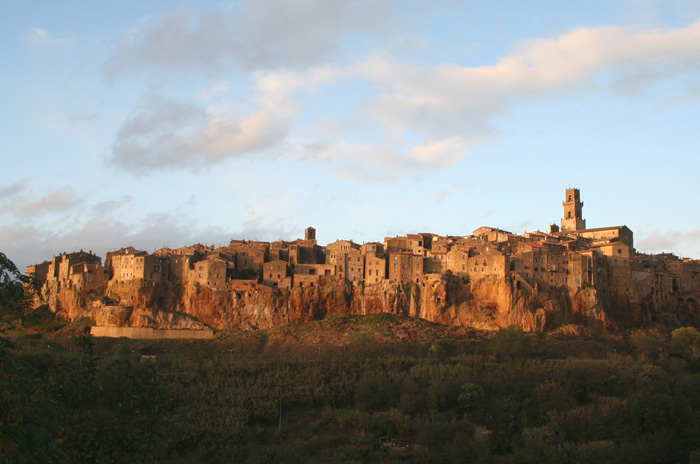 |
|
|
|
|
Pitigliano
|
| |
|
Pitigliano seems to have been taken out of a fairytale. It appears to have grown from the stone of this wildly beautiful promontory, bounded by green valleys crossed by the Lente and Meleta rivers. The high walls of volcanic tufa, carved out by a thousand caverns, project a series of tower-houses, thus heightening the picturesque feel of this medieval town.
|
|
| |
|
Southern Tuscany and Lazio | The Hills of the Etruscan Maremma
|
| Pitigliano |
|
Pitigliano situated on a steep tuff rock, high above the Olpeta, the Fiora and the Lente rivers, is one of the most scenographic villages of Tuscany. In particular arriving from the direction of Manciano, along road n° 74, in correspondence of the curve in front of the church of the Madonna delle Grazie which provides a scenographic backdrop to the town. Besides the splendid town, which is an attraction in itself, the highlights include the Palazzo Orsini, mediaeval but rebuilt in the 16th century, the Citadel fortifications, the Cathedral with an 18th-century façade and the Jewish Synagogue.
The Orsini Fortress stands at the entrance to the old town and overlooks the historic center. Next to it runs the impressive mediaeval aqueduct, that supplied the town with water.
Of further interest is the Jewish history of Pitigliano. For a long time there was an extraordinary large Jewish community, that influenced the cultural life of the town.
The major attraction of Pitigliano, however, is probably its outskirts, very rich in Etruscan and medieval remnants. In the important Necropolises of Poggio Buco, located approximately 8 km from Pitigliano, there are notable varieties of tombs in rooms from the 7th to 6th centuries B.C.
Walk from Pitigliano to Sovana a short but extraordinary walk, following an Etruscan path carved out of living rock three thousand years ago.
|
|
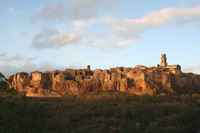 Pitigliano |
| Sovana |
|
Sovana was one of the principal Etruscan cities and was reborn in the Middle Ages when it became the property of the Aldobrandeschi family.
Once you have crossed the threshold of the Rocca Aldobrandesca, you can continue on to Piazza del Pretorio, which has several lovely buildings, such as the Church of Santa Maria, dating from the late Romanesque period, the Palazzo dell’Archivio, with its strange clock, and, facing the church, the Palazzo della Loggia and the Palazzo Pretorio.
In Sovana, you can also experience a walk in the enchanting Vie Cave, imposing walkways excavated from the tufa by the Etruscans, perhaps as communication lanes, perhaps for magic rites. Among the best known is the Cavone. |
|
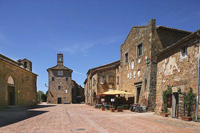
Sovana |
| Magliano |
|
Magliano in Toscana, in southern Tuscany is a gem of a walled town surrounded by olive groves and vineyards. It has historic churches, frescoes and some good restaurants. The beautifully preserved city walls and towers however date from the 14th century, when the original fortress was reconstructed under Sienese rule.
Outside the walls, the elegant Church of Santissima Annunziata contains the remains of fine frescoes from the Bartolo di Preda and Sienese schools of painting. in 1400 it was enlarged with a span, an apses and a bell tower. We can admire great artistic treasures inside, like the valuable painting "The Madonna nursing the Child" by Bartolomeo di Lando, called Neroccio. Behind the church there is the famous Olivo della Strega (witch's olive tree): an over one thousand-year-old tree.
The monastery of San Bruzio, out of town and symbol of Magliano, is also wrapped in legend. Its picturesque ruins stand lonely among the olive trees. In Romanesque style, the monastery was built about in the 13th century. The nearby hilly village, Pereta, is dominated by the Torre dell'Orologio, which was part of the old fortress.
Rectory San Bruzio
The ruins of this beautiful rectory are situated about 2 km East of Magliano in Toscana, in the direction of Orbetello en Marsiliana.
The monastery of San Bruzio, out of town and symbol of Magliano, is also wrapped in legend. Its picturesque ruins stand lonely among the olive trees. In Romanesque style, the monastery was built about in the 13th century. The nearby hilly village, Pereta, is dominated by a big Tower (Torre dell'Orologio), which was part of the old fortress. |
|
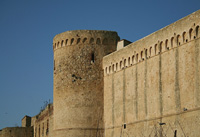
City walls and towers of
Magliano in Toscana
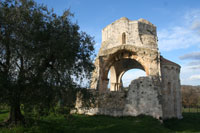
Rectory San Bruzio
|
| Manciano |
|
Manciano is found in the center of an area of greatest archaeological importance.
The most important site in the comune is Saturnia, are the Cascate del Gorello, thermal springs dating to the Roman period.
Manciano, situated on the top of a hill is dominated from the Rocca, today seat of the municipality. Hidden amongst the streets of the Manciano are some splendid treasures of the area’s ancient past, these monuments and buildings tell the history of the countryside and include the Church of San Leonardo, the main sacred building of the town and home to the works of two famous local artists, Peter Aldi and Paris Pascucci; the The Chiesa di San Leonardo , built outside the city walls.
The densely built town centre of the frazione Montemerano, crowned by its leaning Torre di San Lorenzo, is contained within its ancient walls. Montemerano became a power center of the signori dei Baschi, who dominated the comune. The thirteenth-century church is dedicated to San Lorenzo; frescoes remain on its walls, and a polyptych by the Sienese painter Sano di Pietro. At a short distance, in open countryside, is the church of the Madonna del Castuzzo.
The most important site in the comune is Saturnia, an old Etruscan town with medieval walls, remains of a Roman road, and best known for its thermal springs, the Cascate del Gorello, dating to the Roman period and still in use today.
|
|
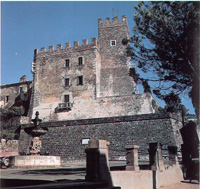
Manciano
|
| Saturnia |
|
The fame of Saturnia is closely linked to its thermal springs, the Terme di Saturnia, known since Roman times. Southern Tuscany, in the area around Monte Amiata, has many natural hot springs. Saturnia is famous all over the world today thanks to the quality of its curative waters, gushing at a constant temperature of 37°C.
The area of Saturnia Spa presents a freely usable area: the waterfalls of Mulino, (Cascata del Mulino, popularly called Gorello), real sulfurous water cascades generated by thermal stream. The waterfall lies in tanks natural limestone, which leave continuously pouring water in the river below Stellata.
However, Saturnia is not only synonymous with thermal baths: the town, set on a travertine plain that dominates the confluence of the Stella torrent with the Albegna river, has a very long history, traces of which are preserved in the buildings and monuments. Another evident symbol of regional history is the Roman gate set into the town walls; these include long stretches of Roman construction and impressive remains from the Etruscan period.
|
|
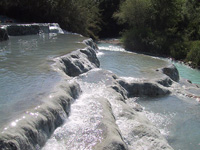
Cascata del Mulino
|
| Montemerano |
|
Montemerano is a picturesque walled village situated on a beautiful hilltop. Montemerano maintains the look of an ancient medieval castle with it’s antique streets and quaint, charming houses. The 14th century Chiesa di San Giorgio is located in the highest part of the historical centre. It is a splendid example of Romanic architecture and houses one of the most important artistic patrimonies in the province of Grosseto. The church houses an important 15th century polyptych and the Virgin of the Gattaiola.
The Madonna was painted by an anonymous painter known only as the Maestro di Montemerano in the 15th century. This piece, thought to have once been a wooden table, depicts the Virgin Mary in all her glory. But it’s the legend that surrounds it that really enthralls…
|
|

Montemerano
|
| Sorano |
|
Sorano is a small village inside the territories of the Maremma, in the heart of that part of Tuscany that is identified with the name of Area del Tufo. The fortress is considered one of the highest examples of Renaissance military architecture.
The village of Sorano is particularly famous for its old town, village, medieval town in which are stored valuable works of ancient art, one of the most beautiful is the Collegiate Church of St. Nicholas.
Walking through the streets of the historic center of Sorano you have the ability to see also other interesting buildings and monuments, the Comitale Palace, the Fortezza Orsini, who was the official residence of the Counts family that dominated the land, and Masso Leopoldino, typical fortress overlooking Sorano from the opposite side of Fortezza Orsini. |
|
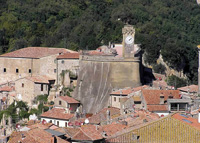
Sorano
|
| Castel Viscardo |
|
Castel Viscardo, which lies 13 km from Orvieto was developed around the Castello dei Duchi di Montevecchio.
Of particular interest are the old kilns right outside the inhabited center, one of the few places where hand-made bricks and tiles are still produced.
By its very nature this production is limited and the products are in great demand. Of the four hamlets which belong to the commune, Monterubiaglio and Viceno both grew up around medieval fortresses. The other hamlets are Le Prese and Pianolungo. |
|
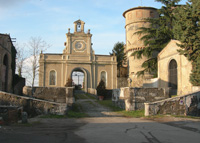
Castel Viscardo
|
| Orvieto |
|
Orvieto still preserves its charming Medieval character, thanks to its location and to its Etruscan roots, dating back to 9th century BC.
Located on a plateau of volcanic tuff, Orvieto is surrounded by a stupendous landscape of fields and vineyards; the unbreachable walls appear to encircle the city rather than elevate it, as though it were a fortress rising on the flat valley floor of the river Paglia.
The Duomo of Orvieto is one of the most important examples of Gothic architecture in Italy. The facade, a great triptych built by Lorenzo Maitani in the first years of the 14th century, is richly decorated in a dazzling mixture of polychrome marble, sculptures and mosaics, is certainly the prime masterpiece of Italian decorative Gothic.
Inside the cathedral, the Chapel of San Brizio is frescoed by Fra Angelico andLuca Signorelli.
|
|
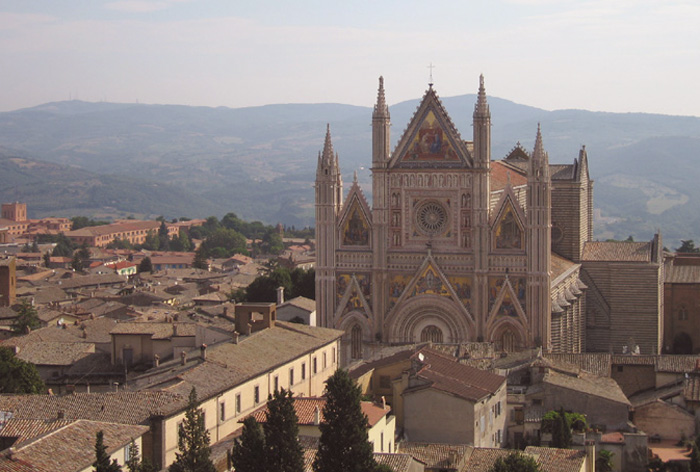
Orvieto, Duomo |
| Acquapendente |
|
Acquapendente is part of the upper portion of Tuscia, bordering Tuscany and Umbria. The most significant monument is the cathedral of Santo Sepolcro, constructed around the year 1000 over the votive chapel that Matilda of Westphalia ordered built with the same dimensions as Christ's sepulchre.
|
|
|
| Cività di Bagnoregio |
|
Civita di Bagnoregio is a small hill town in the province of Viterbo.
The town is noted for its striking position atop a plateau of friable volcanic tuff overlooking the Tiber river valley, in constant danger of destruction as its edges fall off, leaving the buildings built on the plateau to crumble. |
|
 Civita di Bagnoregio Civita di Bagnoregio
|
Lago di Bolsena |
|
Lake Bolsena, lies 100 kms north of Romein a relatively undiscovered part of Italy. The largest volcanic lake in Italy, Bolsena's deep waters are exceptionally clean and sustain a thriving fishing community. Bolsena is the principal tourist centre on the lake's shores.
The old town, founded by the Etruscans, is dominated by the Monaldeschi castle and its raised position affords lovely views of the lake from its squares and medieval streets.
Lake Bolsena is surrounded by a 37-mile long panoramic road that connects Bolsena, Montefiascone, Marta, Capodimonte, and Valentano.
Marta, just a few miles south of Capodimonte, retains a very nice coat of arms of Paulus III at the entrance of the little town. A little fortress protects the town.
In the midst of the lake, accessible by boat taxi, their are two privately owned islands, one (Isola Martana) is closed to the public, but the other (Isola Bisentina), which used to be a summer residence of the Popes, is open. There is a large church and monastery on the island and are several chapels, including one whose interior contains some frescoes possibly by Benozzo Gozzoli, lining its shores.
Latera is located in the fascinating and enchanting territory of the Bolsena Lake, facing the western shores and extremely close to the famous Mezzano Lake.
|
|
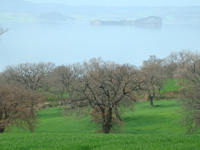
Lago di Bolsena
|
Viterbo
Celleno |
|
Viterbo is famous as the town of the Popes: the Popes had a country residence there, which may still be seen; and it thus became the site of important church councils, and in particular of the first conclave. Its beautiful historical center was conceived in the Middle Ages and preserves the essential style of the medieval architecture of central Italy, with many palaces.
Celleno is located in the eastern part of the Tuscia area of Viterbo. The old village lays on a 476-metres-high green hill on which you can notice a fascinating medieval castle, Castello Orsini. Also in Celleno you can visit the medieval abbey and church rich in artistic masterpieces.
|
|
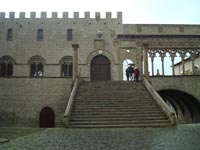
Viterbo
|
| Bomarzo |
|
Bomarzo is a small town, located near Viterbo on the road to Orta. The Castle, Palazzo Orsini di Bomarzo rises at the edge of this small town.
Bomarzo Park, a 16th century villa with grotesque stone sculptures of monstrous porportions, depiciting mythological personalities and creatures taken from classical fables: Pergasus, Hercules, Neptune, Cera. Prince Pier Francesco Orsini built the villa in 1552. Mourning the death of his wife, Giulia Farnese, he erected a temple and stauary in her honor on the grounds. Vicino Orsini didn't call this garden a giardino, but Bosco Sacro, a Sacred Grove or Bosco dei Monstri, the Monsters' grove. Monster must be understood in the Latin meaning of monstrare, which means to show and demonstrate. This then means that from stop to stop, from stage to stage, each element is a component of an immense, very neoplatonic poem to his lost love.
The villa was designed by Architect Pirro Ligorio. Giovanni Bettini purchased the property in 1954, eventually opening it to the public. During the nineteenth century and deep into the twentieth the garden
became overgrown and neglected, but in the 1970s a program of
restoration was implemented by the Bettini family, and today the garden,
which remains private property, is a major tourist attraction.
|
|
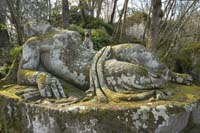
Il parco dei Mostri di Bomarzo
|
| Tarquinia |
|
Tarquinia, a medieval town famous for its archeological remains, is situated just a few kilometres from Tuscany, in Northern Lazio, very close to Capalbio and Monte Argentario and less than 1,5 hour drive from Podere Santa Pia.
Tarquinia is custodian of an incredible number of treasures, including very old constructions, ancient palazzi and historic churches, all of which serve as an extraordinary testimony to the past of this town.
Tarquiniais the Etruscan town per excellence. The frescoed walls of its tombs, famed throughout the world, are covered with the most archaic painting of the italic civilisation. The necropolis of Tarquinia, also known as Monterozzi, contains 6000 tombs, 60 of which include wall paintings.
Tarquinia Etruscan Museum, housed in Palazzo Vitelleschi, is very likely the most important Etruscan Museum in the world.
|
|

Tarquinia, Santa Maria in Castello
|
Tuscania
Vulci
Lago Pellicone |
|
Tuscania is one of the loveliest towns in Upper Lazio. Built on a hilltop by the Etruscans in the 7th century BC, the town was situated in the river Marta valley, about 10 miles from Viterbo.
Vulci, Tarquinia and Tuscania represent the emblems of Etruscan civilization. The ancient city Tuscania was a prosperous Etruscan centre in the 3rd century bc, and Etruscan tombs have been found nearby. In the Medieval historical center the beautiful Roman basilica of San Pietro stands on the old Etruscan acropolis, and has a 13th century façade with symbols of the Evangelists. The basilica, one of the most magnificent monuments in the Viterbo area, probably dates to the eighth century. The interior has massive 11th century columns with beautiful capitals and decorative pavings.
At the foot of the hill stands the church of Santa Maria Maggiore, built during the same period as the church of San Pietro.
Vulci | Castello della Badia
Vulci was the centre of a large city-state, but after the 6th century it had to relinquish parts of this territory to Rome.
In the Castello della Badia you will find the Museo Archeologico Nazionale di Vulci. There are a number of important Etrusco-Roman remains on the site of the ancient city.
In the Natural Park of Vulci we can walk along the paths following the course of the Fiora, along the ancient roads that led from Vulci and Castro to the sea.
|
|
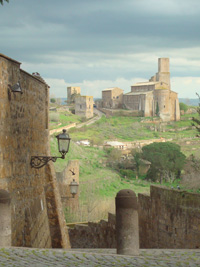
Tuscania
|
| |
|
|
| |
|
|
|
|
|
|
|
|
|
|

Walking in Southern Tuscany | Walking along the Vie Cave, in Pitigliano, Sorano and other Etruscan cities
|
|
|
| |
|
|
|
|
|
|
|
|
|
|

|
|
|
|
 |
|
| |
|
 |
|
|
|
 |
|
|
|
 |
|
|
|
 |
|
|

|
|
|
 |
|
|
|
| |
|

 |
|
|
|
|
|
|
|
